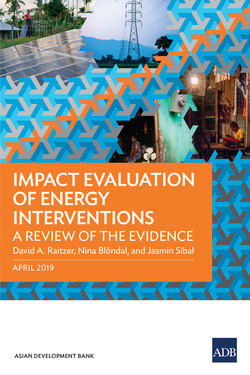Читать книгу Impact Evaluation of Energy Interventions - David A. Raitzer - Страница 7
На сайте Литреса книга снята с продажи.
1. Importance of Impact Evaluation in the Energy Sector
ОглавлениеEnergy is a rapidly evolving area of development assistance. Whereas energy access through conventional infrastructure has been a traditional emphasis, development assistance increasingly recognizes the potential of innovative technologies and policy reforms to contribute to a wider range of outcomes related to sustainability and social development. Yet, even as the objectives of the field have expanded, the existing body of evidence of what works in the energy sector has remained limited.
Many economic analyses have been used to assess the economic gains from energy projects through modeling that relies heavily on assumptions (ADB 2013a, 2017). Until recently, more rigorous studies examining the effects of energy interventions were mainly macroeconomic and based on time series or modeling using partial equilibrium optimization or computable general equilibrium (CGE) techniques (Torero 2014). Most of these models are ex ante, and attempt to compare alternative energy sector policies, in terms of implications for economic growth and/or environmental emissions.
Although useful for forecasting and simulating options, such studies assume, rather than identify, causal relationships and behavioral responses to interventions. Impact evaluation, on the other hand, empirically measures the causal effects of interventions on outcomes of interest, while minimizing assumptions as much as possible. Use of impact evaluation methods for energy interventions began to grow in the early 2000s, but the number of impact evaluations in the energy sector has grown more slowly than in other sectors, and remains small. This is so, because the methodological challenges to applying impact evaluation techniques to infrastructure projects are somewhat larger than for other sectors such as health, education, or social programs.
Nevertheless, increasing numbers of innovative impact evaluations are emerging in the energy sector to address an expanding array of questions. Many energy program and project documents state intentions to improve socioeconomic welfare, such as increased incomes, better education, and improved health. Recent studies have helped to provide causal evidence of such benefits and the pathways through which they occur, but additional impact evaluations are needed to understand how these outcomes may be enhanced. Impact evaluation of energy sector reforms is a frontier area of research. Previous studies offer important insights on which reforms have been effective, but only a tiny share of possible reforms have been subject to rigorous testing. Energy efficiency is increasingly targeted to address sustainability outcomes. Impact evaluation can help test interventions to this end, but the array of options tested to date remains limited.
Impact evaluation techniques can test effects at the levels of both energy consumers and energy suppliers. For example, governments now offer many incentives to promote clean energy supply. Impact evaluation can help to test their effectiveness. Similarly, impact evaluation can test alternative means of ensuring cost recovery, such as separation of power supply feeders for irrigation and for households. These types of insights on responses to measures taken can help in refining energy programs.
This report aims to help orient future impact evaluation work in the energy sector by reviewing what has been produced against what might be possible. To do so, this report offers a brief review of impact evaluation considerations for the energy sector, impact evaluations performed to date, and future directions for impact evaluation studies. It does so by first characterizing energy sector programming and theories of change to identify potential impact evaluation questions. Then it reviews impact evaluations performed to date in terms of interventions and outcomes covered, as well as methods applied. From these two sets of information, gaps in intervention and outcome/impact coverage are identified, and future directions for impact evaluation are proposed.
